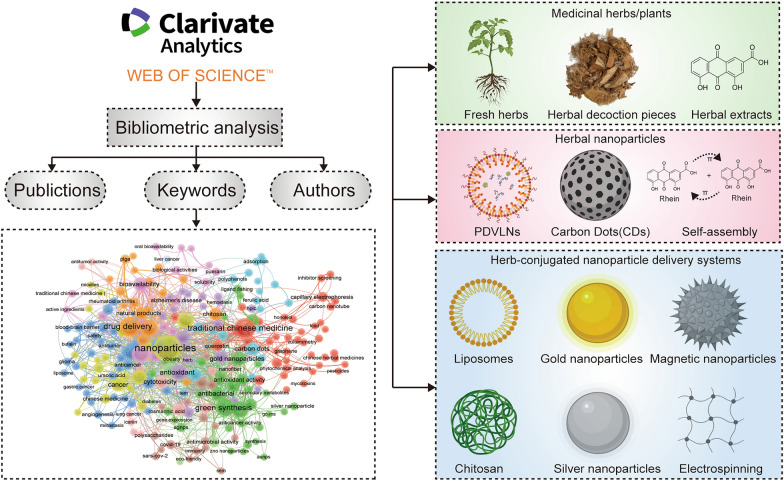- Record: found
- Abstract: found
- Article: found
Collision of herbal medicine and nanotechnology: a bibliometric analysis of herbal nanoparticles from 2004 to 2023

Read this article at
Abstract
Background
Herbal nanoparticles are made from natural herbs/medicinal plants, their extracts, or a combination with other nanoparticle carriers. Compared to traditional herbs, herbal nanoparticles lead to improved bioavailability, enhanced stability, and reduced toxicity. Previous research indicates that herbal medicine nanomaterials are rapidly advancing and making significant progress; however, bibliometric analysis and knowledge mapping for herbal nanoparticles are currently lacking. We performed a bibliometric analysis by retrieving publications related to herbal nanoparticles from the Web of Science Core Collection (WoSCC) database spanning from 2004 to 2023. Data processing was performed using the R package Bibliometrix, VOSviewers, and CiteSpace.
Results
In total, 1876 articles related to herbal nanoparticles were identified, originating from various countries, with China being the primary contributing country. The number of publications in this field increases annually. Beijing University of Chinese Medicine, Shanghai University of Traditional Chinese Medicine, and Saveetha University in India are prominent research institutions in this domain. The Journal “International Journal of Nanomedicine” has the highest number of publications. The number of authors of these publications reached 8234, with Yan Zhao, Yue Zhang, and Huihua Qu being the most prolific authors and Yan Zhao being the most frequently cited author. “Traditional Chinese medicine,” “drug delivery,” and “green synthesis” are the main research focal points. Themes such as “green synthesis,” “curcumin,” “wound healing,” “drug delivery,” and “carbon dots” may represent emerging research areas.
Related collections
Most cited references186
- Record: found
- Abstract: not found
- Article: not found
bibliometrix : An R-tool for comprehensive science mapping analysis
- Record: found
- Abstract: found
- Article: not found
Increased survival in pancreatic cancer with nab-paclitaxel plus gemcitabine.
- Record: found
- Abstract: found
- Article: not found
